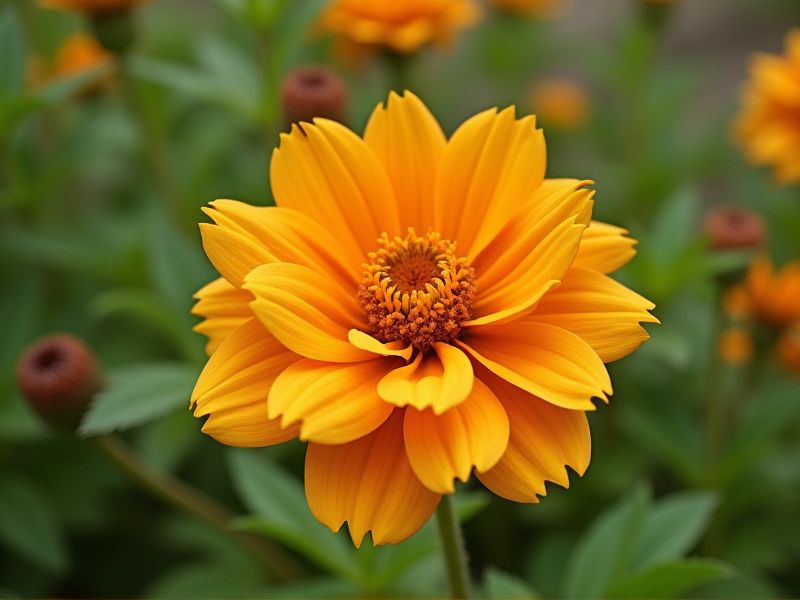
Drought-resistant plants that produce flowers offer vibrant beauty while thriving in arid conditions, making them an excellent choice for water-conscious gardens. Varieties like lavender, succulents such as Echeveria, and desert marigolds not only require minimal irrigation but also provide essential habitats for pollinators. These flowering plants have adapted physiological traits, including deep root systems and water-storing tissues, allowing them to survive in dry environments. Incorporating such species into your landscape enhances biodiversity, reduces water consumption, and ensures seasonal color. Keep in mind that selecting native drought-resistant plants can lead to a more sustainable garden that flourishes with less maintenance.
List of some Drought-resistant plants that flower
- Lavender (Lavandula spp.)
- Yarrow (Achillea millefolium)
- Coneflower (Echinacea purpurea)
- Russian Sage (Perovskia atriplicifolia)
- Blanket Flower (Gaillardia spp.)
- California Poppy (Eschscholzia californica)
- Sedum (Sedum spp.)
- Salvia (Salvia spp.)
- Black-Eyed Susan (Rudbeckia hirta)
- Daylily (Hemerocallis spp.)
Important things about Drought-resistant plants that flower
Water Conservation Strategies
Drought-resistant plants that flower, such as California poppy and desert marigold, are ideal for conserving water in arid environments. These resilient species require minimal irrigation, thriving in dry conditions while offering vibrant blooms that enhance garden aesthetics. Utilizing native plants like these not only reduces water consumption but also supports local ecosystems by attracting pollinators. Incorporating drought-tolerant flowering plants into your landscaping can lead to a sustainable and beautiful outdoor space.
Adaptation To Arid Environments
Drought-resistant plants, such as succulents and certain wildflowers, have evolved unique adaptations to thrive in arid environments. These vegetation types often feature specialized features like thick, fleshy leaves or stems that store water, allowing them to survive prolonged dry spells. Some even possess deep root systems that reach moisture far underground, while others have developed a flowering cycle synchronized with brief rainfall events, maximizing their reproductive success. By cultivating these drought-resistant plants in your own garden, you can promote sustainability while enjoying colorful blooms even in challenging climates.
Native Species Benefits
Drought-resistant native plants, such as Echinacea purpurea (purple coneflower) and Achillea millefolium (yarrow), thrive in arid conditions while providing crucial habitats and food for local wildlife. These flowering species have adapted to conserve water and thrive in well-drained soils, making them ideal for xeriscaping or low-maintenance gardens. By planting these native flowers, you not only contribute to biodiversity but also promote soil health and reduce the need for excessive irrigation. Choosing drought-resistant natives in your landscaping can enhance aesthetic appeal while supporting ecological resilience and sustainability.
Seasonal Flowering Patterns
Drought-resistant plants exhibit unique seasonal flowering patterns, effectively adapting to arid climates by optimizing water usage. Species such as the Desert Marigold and the California Poppy bloom during the cooler months, capitalizing on winter rains to conserve moisture. These plants often possess specialized structures like fleshy leaves and deep root systems, allowing them to thrive in nutrient-poor soils while producing vibrant flowers to attract pollinators. By selecting drought-tolerant flowering plants for your garden, you can create a colorful, low-maintenance landscape that flourishes even in dry conditions.
Soil Tolerance Types
Drought-resistant plants that flower, such as Echinacea (cone flower) and Lavandula (lavender), possess unique adaptations that allow them to thrive in arid conditions while providing vibrant blooms. These plants typically feature deep root systems, which enable them to access moisture from lower soil layers, and succulent leaves that reduce water loss. By selecting drought-tolerant flowering species for your garden, you can create a sustainable landscape that maintains color and beauty even in dry spells. Moreover, these plants require minimal irrigation, making them an eco-friendly choice that conserves water resources.
Sunlight Requirements
Drought-resistant plants that flower thrive best in full sun, typically requiring at least six hours of direct sunlight daily. Popular choices include the vibrant Desert Marigold, which showcases bright yellow blooms, and the striking Red Yucca, known for its tall spikes adorned with tubular flowers. These sun-loving plants not only conserve water but also attract pollinators like bees and butterflies, enhancing your garden's biodiversity. By selecting the right drought-tolerant species, you can create a stunning landscape that flourishes even in arid conditions.
Pollinator Attraction
Drought-resistant plants that flower are essential for sustaining pollinator populations, especially in arid climates. Varieties such as Echinacea, Lavender, and Succulents bloom vibrantly while requiring minimal water, making them ideal for xeriscaping. These hardy plants not only thrive in harsh conditions but also provide nectar and pollen resources that attract bees, butterflies, and other beneficial insects. By incorporating drought-resistant flowering plants into your garden, you create a biodiverse habitat that supports pollinators and enhances your landscape's beauty.
Maintenance And Care
Drought-resistant plants that flower are ideal for water-conscious gardens, showcasing vibrant blooms while conserving resources. Popular varieties include the colorful California poppy, resilient agastache, and low-maintenance evergreen sage, which thrive in arid conditions. Proper maintenance involves selecting well-draining soil, implementing mulching techniques, and establishing deep root systems to enhance resilience against dry spells. Regular observation for pests and diseases can ensure your drought-resistant garden remains healthy and visually appealing throughout the growing season.
Planting Zones Compatibility
Understanding your planting zone is crucial for selecting drought-resistant flowering plants that thrive even in arid conditions. Native flora, such as the California poppy or desert marigold, not only requires less water but also supports local ecosystems and wildlife. Other dependable options include succulents like the agave or the striking red yucca, both of which add vibrant color to your garden while conserving water. By choosing the right species based on your USDA hardiness zone, you can create a sustainable garden that blooms beautifully without excessive maintenance.
Aesthetic Landscape Options
Drought-resistant flowering plants, such as lavender, coneflower, and gazania, add vibrant colors to your landscape while conserving water. These resilient species thrive in arid conditions, requiring minimal irrigation once established. Incorporating native varieties not only enhances your garden's aesthetic appeal but also supports local ecosystems and wildlife. By choosing these adaptable plants, you can create a stunning, low-maintenance garden that flourishes even in dry climates.
